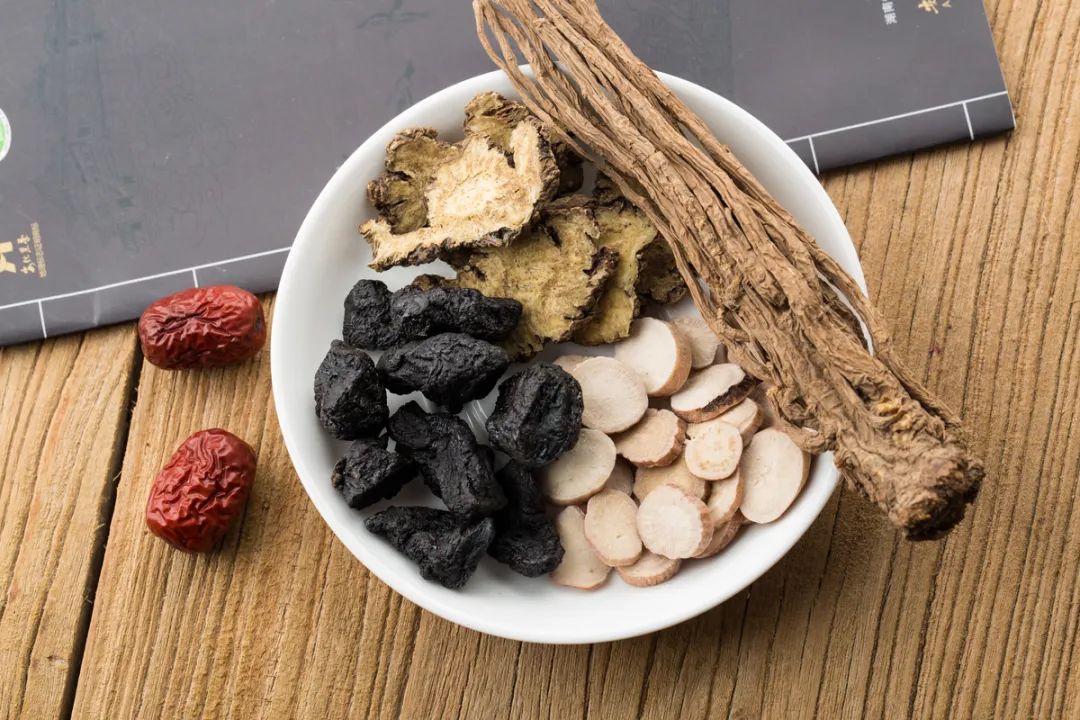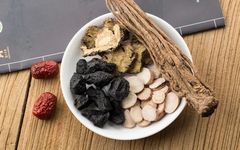Traditional Chinese Medicine (TCM) believes that individuals with qi and xue deficiency or those with a relatively weak constitution need to regulate their condition through blood replenishment. So, what are the best foods for nourishing blood? Recipes for qi and xue replenishing dishes include Si Wu Tang (Four Substance Decoction), Xue Fu Zhu Yu Tang (Blood Mansion Decoction to Remove Stasis), Dang Gui Wu Ji Tang (Angelica Black Chicken Soup), Yi Mu Cao Da Zao Tang (Motherwort and Jujube Soup), Dan Shen Hu Xin Fang (Salvia Heart Protecting Formula), Ejiao Hua Sheng Ren Da Zao Tang (Donkey-hide Gel, Peanut, and Jujube Soup), Yu Ling Gao (Jade Spirit Paste), Hong Zao Gui Yuan Cha (Red Date and Longan Tea), Xi Yang Shen Qiao Mai Zhou (American Ginseng and Buckwheat Porridge), and Shan Zha Tao Ren Lu (Hawthorn and Peach Kernel Drink). Let’s explore the detailed knowledge related to blood nourishing dishes!
Top 10 Blood Nourishing Recipes
1. Si Wu Tang
This classic TCM recipe for nourishing blood is effective in alleviating dysmenorrhea.

Si Wu Tang is a time-honored formula that nourishes blood without causing stagnation, harmonizes blood without harming it. Therefore, it can be used by those with blood deficiency to replenish blood, and by those with blood stasis to invigorate blood circulation. However, it should be avoided during menstruation and is not suitable for individuals with a heat constitution, spleen and stomach deficiency, or those suffering from wind-cold colds. What are the four ingredients of Si Wu Tang? The standard formula includes Chuan Xiong (Chuanxiong Rhizome) 8g, Dang Gui (Angelica) 10g, Bai Shao (White Peony) 12g, and Shu Di Huang (Rehmannia) 12g. How to prepare Si Wu Tang? Soak the four herbs in cold water for more than half an hour until softened, then place them in a pot, add an appropriate amount of water, bring to a boil over high heat, then simmer for 40-50 minutes. Additionally, Si Wu Tang has many variations, such as Tao Hong Si Wu Tang, which adds Tao Ren (Peach Kernel) and Hong Hua (Safflower) to specifically treat blood stasis leading to reduced menstrual flow. 【Details>>】
2. Xue Fu Zhu Yu Tang
Invigorates blood, removes stasis, promotes qi flow, and alleviates pain.
Xue Fu Zhu Yu Tang is a TCM formula known for regulating blood, with the effects of invigorating blood circulation and removing stasis, promoting qi flow, and alleviating pain. However, it is contraindicated for pregnant women, nursing mothers, individuals with bleeding tendencies, and those with allergies. The standard formula includes Tao Ren 12g, Hong Hua 9g, Dang Gui 9g, Sheng Di Huang 9g, Niuxi 9g, Chuan Xiong 4.5g, Jie Geng 4.5g, Chi Shao 6g, Zhi Ke 6g, Gan Cao 6g, and Chai Hu 3g. Soak all the herbs in cold water for half an hour, then add an appropriate amount of water and simmer for half an hour. Strain the liquid, then repeat the process two more times, mixing the three decoctions together for consumption. Note that Xue Fu Zhu Yu Tang is a representative ancient formula from the Qing Dynasty by Wang Qingren in his work Yilin Gai Cuo, with slight modifications made later. Please consult a physician before preparing and consuming this formula.
3. Dang Gui Wu Ji Tang
Moistens the intestines, promotes bowel movements, regulates menstruation, and nourishes blood.
Dang Gui Wu Ji Tang is a medicinal dish made primarily from Dang Gui (Angelica) and black chicken. Dang Gui is a commonly used medicinal and edible ingredient, warm in nature, sweet and pungent in flavor, and enters the liver, heart, and spleen meridians. Black chicken is neutral in nature and sweet in flavor, with excellent therapeutic effects. Dang Gui Wu Ji Tang has benefits for beauty, moistening the intestines, regulating menstruation, and nourishing blood, making it suitable for those with menstrual irregularities and qi and blood deficiency. However, it is contraindicated for pregnant women, those with excessive menstruation, and individuals with uremia. The preparation involves using 30g of Dang Gui, 10g of ginseng, 30g of goji berries, and 500g of black chicken, with optional additions of ginger, carrots, red dates, and tangerine peel. After slaughtering the black chicken, remove the internal organs and head, wash the remaining parts, and wrap the herbs in clean gauze, placing them inside the chicken’s abdomen. Simmer over high heat for 2-3 hours.
4. Yi Mu Cao Da Zao Tang
Nourishes blood, removes stasis, and alleviates dysmenorrhea.
Yi Mu Cao (Motherwort) can invigorate blood, regulate menstruation, promote diuresis, and reduce swelling; Da Zao (Jujube) can tonify the spleen and stomach, benefit qi, and generate fluids, thus ensuring sufficient qi and blood, improving symptoms like sallow complexion due to blood deficiency. The combination of these two ingredients can warm the meridians, nourish blood, remove stasis, and relieve pain. However, it is not suitable for pregnant women, those with yin deficiency and low blood, or those with unstable conditions. How to prepare Yi Mu Cao Da Zao Tang? Use 10g of Yi Mu Cao, 20g of Da Zao, 10g of Hong Hua, 50g of brown sugar, and 50g of rice wine. Place the Yi Mu Cao, Da Zao, and Hong Hua in a clean gauze bag, put it in a clay pot, add an appropriate amount of water, bring to a boil, then add rice wine and brown sugar, simmer for about an hour, remove the herb bag, and drink the soup.
5. Dan Shen Hu Xin Fang
Invigorates blood and removes stasis.
Dan Shen (Salvia) is a herb that invigorates blood and removes stasis, with functions of promoting blood circulation, alleviating pain, calming the heart, and cooling the blood. However, it should be used cautiously by those with excessive menstruation and pregnant women. How to prepare Dan Shen Hu Xin Fang? Use 9g of Dan Shen, 9g of Shan Zha (Hawthorn), 9g of San Qi (Notoginseng), and 9g of Xi Yang Shen (American Ginseng). For optimal effects, grind all the herbs into powder and take them with warm or cool boiled water. Note that Dan Shen, San Qi, and Xi Yang Shen should not be taken in excess, and it is best to use them under the guidance of a physician based on individual health conditions.
6. Ejiao Hua Sheng Ren Da Zao Tang
Replenishes both qi and blood, nourishes yin, and benefits the stomach.
Ejiao (Donkey-hide Gel) has the effects of nourishing blood, invigorating blood, and replenishing deficiency, used for symptoms like sallow complexion, dizziness, palpitations, and insomnia due to blood deficiency. Hua Sheng Ren (Peanut) is also known as the “longevity fruit,” which can delay aging and promote children’s bone development. The combination of Ejiao, Hua Sheng Ren, and Da Zao can replenish both qi and blood, nourish yin, and benefit the stomach. How to prepare Ejiao Hua Sheng Ren Da Zao Tang? Use 9g of Ejiao, 20g of Hua Sheng Ren, 15g of longan meat, 3 Da Zao, and an appropriate amount of brown sugar. Place the peanuts, longan meat, and jujubes in a clay pot, add an appropriate amount of water, bring to a boil, then simmer for 1 hour, add Ejiao until dissolved, and finally add brown sugar to taste.
7. Yu Ling Gao
Improves blood deficiency, benefits qi, and calms the spirit.
Yu Ling Gao is an ancient TCM dietary therapy formula originating from the work of Qing Dynasty TCM master Wang Mengying’s Suixi Ju Yin Shi Pu. It is a premium formula for replenishing blood and qi, suitable for those with blood and qi deficiency, poor complexion, fatigue, palpitations, and insomnia. However, it is contraindicated for pregnant women, not recommended for children, and should be avoided by those with phlegm-heat or damp-heat accumulation, as well as during colds. The preparation involves washing longan meat and mixing it with Xi Yang Shen (American Ginseng) powder in a 10:1 ratio, placing it in a steaming bowl; steam in a pot for 40 hours to allow the heat of the longan meat to dissipate, resulting in a balanced paste. Consumption method: Take a small spoonful of Yu Ling Gao in a cup, add hot water to dissolve.
8. Hong Zao Gui Yuan Cha
Nourishes blood, replenishes blood, and benefits qi.
Gui Yuan Hong Zao Cha is a beverage made primarily from dried red dates and longan meat, used for nourishing and recuperating after anemia, illness, or postpartum recovery. The preparation involves washing the red dates, cutting them in half to remove the pits, placing the red dates, longan meat, and rock sugar in a pot, adding water, bringing to a boil, then simmering for about 30 minutes until the liquid reduces. Maintain low heat, stirring to mash the dates into a paste while reducing the liquid. Once cooled, mix with honey and store in a clean glass jar. For consumption, take about 10g, dissolve in warm water. Additionally, other nourishing teas include Nu Shen Liu Bao Cha and Hong Shen Huang Qi Nu Shen Cha, with ingredients like Xi Yang Shen, lily, bird’s nest, goji berries, and red dates having similar effects.
9. Xi Yang Shen Qiao Mai Zhou
Regulates qi and blood deficiency.
Xi Yang Shen can nourish yin, replenish qi, and invigorate blood; Qiao Mai (Buckwheat) is rich in dietary fiber, which aids digestion and promotes appetite. The combination of these two not only regulates qi and blood deficiency but also improves gastrointestinal function. However, it is not suitable for those with spleen and stomach deficiency or those experiencing exterior pathogens. How to prepare Xi Yang Shen Qiao Mai Zhou? Use 3g of Xi Yang Shen and 100g of Qiao Mai. Wash the Xi Yang Shen and soak for 12 hours, then chop; wash the Qiao Mai and set aside. In a pot, combine the Qiao Mai, chopped Xi Yang Shen, and the soaking water, add an appropriate amount of water, bring to a boil, then simmer for 1 hour, and allow to cool before consumption. Note that Xi Yang Shen is a medicinal herb and should be taken under the guidance of a physician.
10. Shan Zha Tao Ren Lu
Invigorates blood, removes stagnation, and aids digestion.
Shan Zha Tao Ren Lu is a medicinal dish made from fresh hawthorn fruit or hawthorn slices, peach kernels, and honey, which invigorates blood circulation, removes stasis, and increases serum albumin, helping to balance blood pressure and lipids. The preparation involves soaking 1000g of fresh hawthorn fruit or 500g of hawthorn slices, 100g of peach kernels, and 250g of honey in cold water for 1 hour. Using the method of decocting Chinese herbs, combine the first and second decoctions, strain, place in a porcelain bowl, and steam with honey for 1 hour. After cooling, bottle and seal. Take one spoonful with warm water after meals. Additionally, San Qi powder can be used to remove blood stasis, and for blood stasis, San Qi 0.5g + Xi Yang Shen 0.5g can be decocted; for post-fracture blood stasis, use San Qi 10g + 5 chicken leg bones to boil water; for blood replenishment and calming the spirit, use 2 slices of ginger + 20g of longan to decoct.

